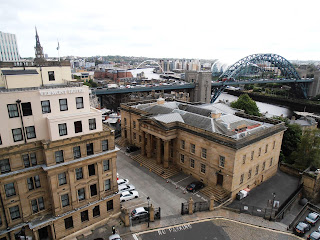This morning we headed on the Metro back into Newcastle in an
attempt to see the rest of the attractions on our list. After our forty minute
trip, we emerged from the underground, today making an effort to examine the Central
Railway Station which we had had occasion to visit before, but then in search
of its conveniences rather than to admire the architecture.
Three men are credited with the order and pleasant design of 1800s
development of Newcastle; architect John Dobson, builder Richard Grainger and a
town clerk named John Clayton. According to one source I have to hand, Dobson’s
masterpiece is the porticoed Central Station, apparently one of the great
monuments to the railway age. It was opened by Queen Victoria in 1850 and when
it was completed, covered an area of seventeen acres and had more than two
miles of platforms. Today we examined the structure critically from laymen’s
eyes. It is an impressive centre, however without the literary prompt, I
probably would not have paid it too much more attention.
 |
| St Nicholas's Cathedral |
Just down the street we found the Castle of Newcastle, or rather
the remains of the castle, because these days a rail line separates the Black Gate
from the keep. Tickets are sold in the gatehouse and the keep is accessed a
short distance away by passing under the rail viaduct built in more recent
times.
The Black Gate was the last addition to the medieval castle
defences, built between 1247 and 1250 and today is a Grade I Listed building,
as so many of the buildings in this green and pleasant land are.
 |
| Black Gate |
 |
| Views from the Keep |
 The “New Castle” which gave the town its name, was founded in 1080
by the eldest son of William the Conqueror, Robert Curthouse and was built
using earth and timber. Between 1168 and 1178 the castle was rebuilt in stone,
the delay caused when it was besieged by the Scots.
The “New Castle” which gave the town its name, was founded in 1080
by the eldest son of William the Conqueror, Robert Curthouse and was built
using earth and timber. Between 1168 and 1178 the castle was rebuilt in stone,
the delay caused when it was besieged by the Scots.
The Castle’s keep had two main functions; it was the principal
strongpoint of the castle and the living space for the commander of the
garrison. Today one can see the late Norman chapel, the well with a depth of
more than 100 feet and the Great Hall. And best of all, forward sloping stone
steps take the tourist to the top of the keep from which there are absolutely
marvellous views over the city.
We spent some time in the basement of the keep learning how it had
for several centuries served as the Northumberland remand gaol, for those who
waited for the circuit judge to rule over the next session of the assizes. In
later years, the roof was no longer functional, and conditions were absolutely
appalling for the inmates who were chained to the wall with no toilets and no
division of age or gender.
Escaping from the confines of the Castle, we found a
sheltered spot nearby, albeit littered and with no pleasant aspect, where we
dined before heading further up into the city. A little beyond the Central Station
is the city’s other cathedral, the Roman Catholic Cathedral of St Mary, this
built in Gothic style in 1844 by Augustus Pugin who also assisted with the
design of the Houses of Parliament. This was altogether more pleasing, light,
bright and welcoming; unlike most of the Anglican places of worship, the
Catholic churches and cathedrals are more popular, the congregations still
active, because regular attendance is more obligatory than those who pursue
other brands of the Christian faith.
 |
| Cathedral of St Mary |
On
arrival one is confronted by the 35 metre long Turbinia, the world’s first
steam turbine powered ship, built by Charles Parsons. The galleries are spread
over several floors that surround the central exhibition area and it was the
Newcastle Story and another all about the River Tyne that caught our attention.
It is very well curated, although I did find the many audio exhibitions rather
differcult to sift through, but that is probably because my hearing is
confused, a condition of maturity.
We did not see everything in the museum, but the remainder of the
galleries suggested duplication of natural history and science seen elsewhere.
We set off again, this time further up the hill, through the Chinatown arch and
then down into the Intu Eldon Square, the biggest indoor shopping mall in
Britain when it was opened in 1977. It has 150 stores set over a retail floor
area of 130,100 square metres. I am sure we have visited larger shopping
centres, but this should not detract from the fact that it did hold, for a
while, the nation’s record. Apparently the Intu Metrocentre just across the river at
Gateshead, opened in 1986, has a retail area of 190,000 square metres with more
than 340 shops, so the record has been long broken and by such a near
neighbour.
From here we walked back down Grainger Street to the station and
caught the train home, today almost bursting at the seams, and with quite a few
seamier types. The rain had stayed away all day, but according to our ever
cheerful neighbour should return with a vengeance tomorrow.

No comments:
Post a Comment